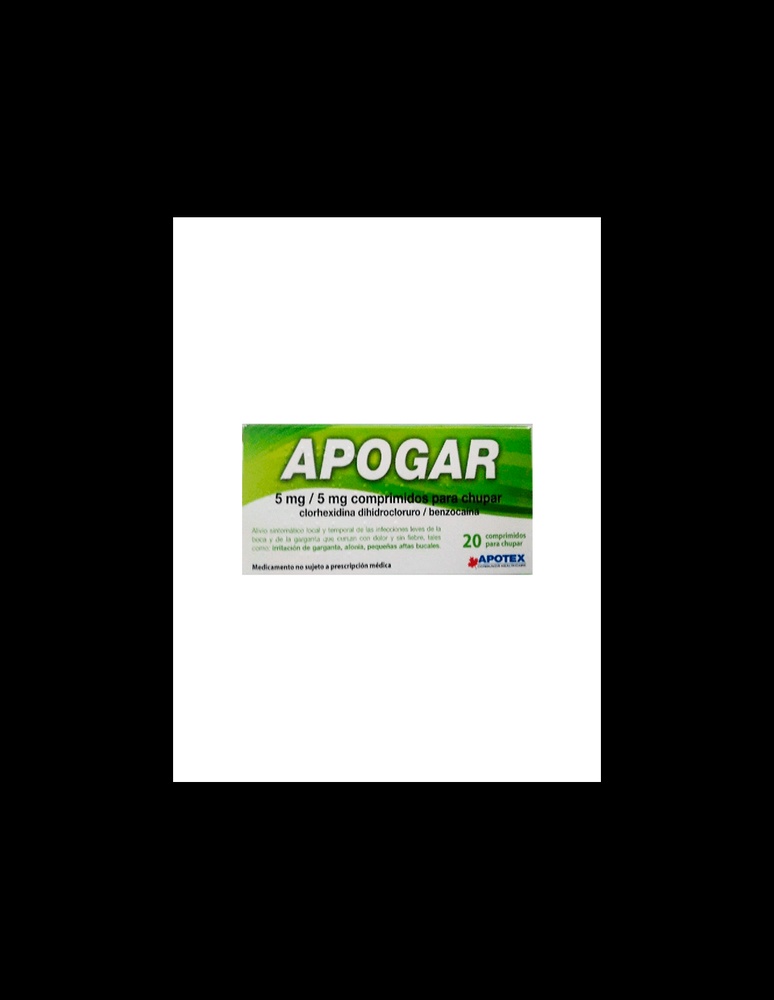

APOGAR 5MG/5MG LOZENGES

Ask a doctor about a prescription for APOGAR 5MG/5MG LOZENGES

How to use APOGAR 5MG/5MG LOZENGES
Introduction
Leaflet: Information for the user
Apogar 5 mg/5 mg lozenges
Chlorhexidine dihydrochloride/Benzocaine
Read the entire leaflet carefully before starting to take this medication, as it contains important information for you.
Follow the administration instructions for the medication contained in this leaflet or as indicated by your doctor or pharmacist.
- Keep this leaflet, as you may need to read it again.
- If you need advice or more information, consult your pharmacist.
- If you experience side effects, consult your doctor or pharmacist, even if they are not listed in this leaflet.
- You should consult your doctor if your condition worsens or does not improve after 2 days.
Contents of the leaflet
- What Apogar is and what it is used for
- What you need to know before taking Apogar
- How to take Apogar
- Possible side effects
- Storage of Apogar
- Package contents and additional information
1. What Apogar is and what it is used for
The active ingredients of this medication work by combining the antiseptic and disinfectant action of chlorhexidine with the local anesthetic action of benzocaine.
This medication is used for the symptomatic local and temporary relief of mild mouth and throat infections that occur with pain and without fever, such as: throat irritation, hoarseness, small mouth sores, from 6 years of age.
2. What you need to know before taking Apogar
Do not take Apogar
- if you are allergic to the active ingredients or to any of the other components of this medication, including those listed in section 6.
A
Consult your doctor or pharmacist before starting to take this medication:
- if you do not tolerate other local anesthetics such as para-aminobenzoic acid (PABA), parabens, or paraphenylenediamine (a hair dye component),
- if you are an elderly patient or your immune system is weakened, you may need lower doses; in case of doubt, consult a doctor,
- if you have a severe or extensive injury in the mouth,
- if you have periodontitis (gum disease), as chlorhexidine may cause an increase in supragingival calculus,
- it is recommended to maintain good oral hygiene to reduce plaque accumulation and possible tooth discoloration that may be caused by chlorhexidine,
- do not take higher doses than recommended in section 3 (How to take Apogar).
Use of other medications
Tell your doctor or pharmacist if you are using or have recently used other medications, including those purchased without a prescription.
Although they are not described in the recommended conditions of use, do not use with other medications for mouth or throat application without consulting your doctor or pharmacist.
This is especially important in the case of:
- Other mouth or throat antiseptics.
- Cholinesterase inhibitor medications (medications for Alzheimer's disease).
- Sulfonamides (used for infections).
Anionic compounds and suspending agents, common components of toothpastes, reduce the effectiveness of chlorhexidine, so the mouth should be rinsed well after using toothpaste.
Interference with diagnostic tests
This medication may interact with the pancreatic function test that uses bentiromide. Do not take this medication at least three days before the test and inform your doctor.
Children and adolescents
This medication should be administered to children over 6 years of age. For the administration form in children over 6 years of age, see section 3.
How to take Apogar
It should be used with caution as methemoglobinemia (difficulty breathing, dizziness, fatigue, weakness) may occur.
Use of Apogar with other medications
Tell your doctor or pharmacist if you are taking, have recently taken, or may need to take any other medication.
Although they are not described in the recommended conditions of use, do not use with other medications for mouth or throat application without consulting your doctor or pharmacist.
This is especially important in the case of:
- Other mouth or throat antiseptics (disinfectants).
- Cholinesterase inhibitor medications (medications for Alzheimer's disease).
- Sulfonamides (used for infections).
Anionic compounds and suspending agents, common components of toothpastes, reduce the effectiveness of chlorhexidine, so the mouth should be rinsed well after using toothpaste.
Pregnancy and breastfeeding
If you are pregnant, breastfeeding, think you may be pregnant, or plan to become pregnant, consult your doctor or pharmacist before using this medication.
Taking medications during pregnancy can be hazardous to the embryo or fetus and should be monitored by your doctor.
Driving and using machines
No cases have been reported that affect the ability to drive or use machines.
3. How to take Apogar
Follow the administration instructions for this medication as indicated by your doctor or pharmacist. In case of doubt, consult your doctor or pharmacist.
The recommended dose is:
Adults, adolescents, and children over 6 years of age
1 lozenge every 2 or 3 hours, dissolving it slowly in the mouth.
Do not take more than 8 lozenges in 24 hours (1 day).
Dissolve the lozenge slowly in the mouth without chewing or swallowing.
Elderly patients
Elderly patients and more debilitated patients may be more sensitive to benzocaine, so lower concentrations of this medication may be needed.
This medication is for buccopharyngeal use, so the lozenges should be dissolved slowly in the mouth without chewing or swallowing, as its action is local and only occurs when the product is in direct contact with the affected area.
Always use the lowest effective dose.
If you notice that your symptoms worsen or persist for more than 2 days after starting treatment or if you develop a fever, headache, nausea, or vomiting, you should consult your doctor as soon as possible.
If you take more Apogar than you should
Signs of overdose are: slurred speech, numbness, staggering gait, blurred or double vision, dizziness, excitement, or convulsions, ringing in the ears, increased sweating. A decrease in blood pressure may also occur.
In case of overdose or accidental ingestion, consult your doctor or pharmacist immediately, or call the Toxicology Information Service, phone 91 562 04 20, indicating the medication and the amount ingested.
If you forget to take Apogar
Do not take a double dose to make up for forgotten doses.
If you have any other questions about the use of this medication, ask your doctor or pharmacist.
4. Possible side effects
Like all medications, Apogar can cause side effects, although not everyone will experience them.
The most characteristic adverse reactions due to benzocaine are:
Tooth discoloration may appear, especially in people with plaque accumulation on their teeth. This alteration of tooth color is not permanent and can be eliminated through a dental cleaning. The color of fillings may also be altered, in which case this discoloration may be permanent.
Alteration in taste perception may occur.
Irritation in the mouth or irritation of the tip of the tongue or numbness of the tongue may occur, which are usually transient, lack of sensitivity in the mouth, stomatitis (inflammation of the oral mucosa), desquamation of the mucosa, burning sensation in the mucosa, change in taste perception; discoloration of teeth, tongue, fillings, and dentures; increased plaque, as well as hypersensitivity reactions such as urticaria, angioedema (swelling of certain areas of the skin), anaphylactic reaction, or anaphylactic shock, mainly due to chlorhexidine.
Inflammation of the parotid gland has also been reported.
Some cases of methemoglobinemia caused by benzocaine have been reported, with symptoms such as difficulty breathing, cyanosis (bluish discoloration of the skin and mucous membranes), altered mental state, headache, fatigue, difficulty exercising, dizziness, and loss of consciousness.
In some cases, this medication may cause irritation in the mouth or irritation of the tip of the tongue, which are usually transient, as well as allergic reactions to chlorhexidine or benzocaine.
Reporting side effects
If you experience any of the side effects, consult your doctor or pharmacist, even if they are not listed in this leaflet. You can also report them directly through the Spanish Medication Surveillance System for Human Use: www.notificaRAM.es. By reporting side effects, you can contribute to providing more information on the safety of this medication.
If you consider that any of the side effects you are experiencing are serious or if you notice any side effect not mentioned in this leaflet, inform your doctor or pharmacist.
5. Storage of Apogar
Keep this medication out of the sight and reach of children.
Store below 30°C.
Do not use this medication after the expiration date shown on the packaging, after "EXP". The expiration date is the last day of the month indicated.
Medications should not be disposed of through wastewater or household waste. Deposit the packaging and any unused medications at the SIGRE collection point in your pharmacy. If in doubt, ask your pharmacist how to dispose of the packaging and any unused medications. This will help protect the environment.
6. Package contents and additional information
Composition of Apogar
The active ingredients are chlorhexidine dihydrochloride and benzocaine.
Each lozenge contains 5 mg of chlorhexidine dihydrochloride and 5 mg of benzocaine.
The other components (excipients) are: mannitol (E-421), microcrystalline cellulose (E-460), povidone, magnesium stearate, sodium cyclamate, sodium saccharin (E-954), menthol flavor, and orange flavor.
Appearance of the product and package contents
Apogar are lozenges with an orange flavor, white-yellowish in color, rounded, and scored on one side.
Aluminum blister pack coated with PVDC and layered with PVC/PE/PVDC. Available in packages of 20 lozenges.
Marketing authorization holder and manufacturer
Marketing authorization holder
Aurovitas Spain, S.A.U.
Avda. De Burgos, 16-D
28036 Madrid
Spain
Manufacturer
Laboratorios Alcalá Farma, S.L.
Avenida de Madrid 82
28802 Alcalá de Henares (Madrid)
Date of the last revision of this leaflet:June 2025
Detailed information about this medication is available on the website of the Spanish Agency for Medicines and Health Products (AEMPS) http://www.aemps.gob.es/
- Country of registration
- Prescription requiredNo
- Manufacturer
- This information is for reference only and does not constitute medical advice. Always consult a licensed doctor before taking any medication. Oladoctor is not responsible for medical decisions based on this content.
- Alternatives to APOGAR 5MG/5MG LOZENGESDosage form: TOPICAL ORAL PRODUCT, 10 mg/mlActive substance: povidone-iodineManufacturer: Cooper Consumer Health B.V.Prescription not requiredDosage form: GEL/PASTE/ORAL LIQUID, 10% povidone iodineActive substance: povidone-iodineManufacturer: Cooper Consumer Health B.V.Prescription not requiredDosage form: BUCCAL TABLET/LOZENGE, 2mg lidocaine/0.6mg amylmetacresol/1.2mg diclofenac alcoholActive substance: variousManufacturer: Laboratorios Cinfa S.A.Prescription not required
Alternatives to APOGAR 5MG/5MG LOZENGES in other countries
The best alternatives with the same active ingredient and therapeutic effect.
Alternative to APOGAR 5MG/5MG LOZENGES in Poland
Alternative to APOGAR 5MG/5MG LOZENGES in Ukraine
Online doctors for APOGAR 5MG/5MG LOZENGES
Discuss dosage, side effects, interactions, contraindications, and prescription renewal for APOGAR 5MG/5MG LOZENGES – subject to medical assessment and local rules.














